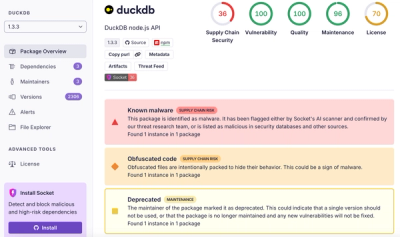
Product
Introducing Tier 1 Reachability: Precision CVE Triage for Enterprise Teams
Socket’s new Tier 1 Reachability filters out up to 80% of irrelevant CVEs, so security teams can focus on the vulnerabilities that matter.
@istex/istex-merge
Advanced tools
Library to build merged documents and generate Hal TEIs from them.
npm install @istex/istex-merge
Function to create a merged document from multiple documents with a set of rules.
A mapping example can be found here.
This JSON file's structure is as follows:
{
"corpusName": true,
"source": true,
"sourceId": false,
"sourceUid": {
"action": "merge",
"path": "sourceUids"
},
// ...
"title.default": true,
"title.en": true,
"title.fr": true,
"utKey": false,
// ...
"business.duplicates": {
"action": "merge",
"id": "sourceUid"
},
// ...
"business.hasFulltext": false,
"fulltextUrl": true
}
This file describes the fields that will be present in the generated merged document.
The default mapping is exported, which means you can build your own mapping from it without having to recreate everything. This can be done like so:
const { defaultMapping } = require('@istex/istex-merge');
// default: true
defaultMapping.authors = false;
Note:
istex-merge can merge data coming from all sources. The two possible scenarios are:
sourceUid field is merged and placed into sourceUids (we make it plurial because the value becomes an array).business.duplicates): a property (sourceUid in the example above) must be used to discriminate the values and remove potential duplicates if the values are objects.An example file describing the priority rules can be found here.
This JSON file's structure is as follows:
{
"priorities": [
"hal",
"crossref",
"pubmed",
"sudoc"
],
"keys": {
"corpusName": [/*...*/],
"source": [/*...*/],
"sourceId": [/*...*/],
"sourceUid": [/*...*/],
// ...
"title.default": [/*...*/],
"title.fr": [/*...*/],
"title.en": [/*...*/],
"utKey": [/*...*/],
// ...
"business.hasFulltext": [/*...*/],
"fulltextUrl": [/*...*/]
}
}
The priority mechanism:
priorities defines the default priority order. It is applied to every field without a specific priority order.keys.<field> defines a specific priority order for <field>. Use an empty array ([]) to tell istex-merge to use the default priority order.The default rules are exported, which means you can build your own rules from them without having to recreate everything. This can be done like so:
const { defaultRules } = require('@istex/istex-merge');
// default: ['sudoc-theses', 'sudoc-ouvrages', 'hal', 'pubmed', 'crossref']
defaultRules.keys.abstract = ['pubmed', 'crossref', 'hal'];
This library must be integrated in an environment with direct access to the docObjects.
const { generateMergedDocument, defaultRules, defaultMapping } = require('@istex/istex-merge');
const docObjects = [{...}, {...}, {...}];
defaultRules.keys.abstract = ['pubmed', 'crossref', 'hal'];
defaultMapping.authors = false;
const mergedDocument = generateMergedDocument(docObjects, { rules: defaultRules, mapping: defaultMapping });
Considering the following list of documents:
[
{
"source": "hal",
"authors": [],
"abstract": {
"fr": "abstract.hal.fr",
"en": "abstract.hal.en"
}
},
{
"source": "crossref",
"authors": [
"authors.crossref.1",
"authors.crossref.2"
],
"abstract": {
"fr": "abstract.crossref.fr",
"en": "abstract.crossref.en"
}
},
{
"source": "pubmed",
"authors": [
"authors.pubmed.1",
"authors.pubmed.2"
],
"abstract": {
"fr": "abstract.pubmed.fr",
"en": "abstract.pubmed.en"
}
},
{
"source": "sudoc",
"authors": [
"authors.sudoc.1",
"authors.sudoc.2"
],
"abstract": {
"fr": "abstract.sudoc.fr",
"en": "abstract.sudoc.en"
}
}
]
Note: The docObjects used to create the merged document MUST contain a source field.
I want to build a merged document according to the following rules:
abstract.fr, use data coming from "crossref", then "pubmed" and finally "sudoc".abstract.en, use data coming from "pubmed", then "sudoc".I, thus, use the following JSON file:
{
"priorities": [
"hal",
"crossref",
"pubmed",
"sudoc"
],
"keys": {
"authors": [],
"abstract.fr": [
"crossref",
"pubmed",
"sudoc",
"hal"
],
"abstract.en": [
"pubmed",
"sudoc",
"crossref",
"hal"
]
}
}
Which will give me the following result:
{
"source": "hal",
"authors": [
"authors.crossref.1",
"authors.crossref.2"
],
"abstract": {
"fr": "abstract.crossref.fr",
"en": "abstract.pubmed.en"
},
"origins": {
"authors": "crossref",
"abstract.fr": "crossref",
"abstract.en": "pubmed",
"sources": [
"hal",
"crossref",
"pubmed"
]
}
}
Description:
source: the base sourceorigins.<field>: the source that was modified by istex-merge for <field>origins.sources: an array compiling all the sources used in the merged documentauthors), istex-merge will go down the priority list until it finds a source with data for this field.Function to generate a Hal TEI from a merged document.
Generate a merged document using the generateMergedDocument function.
const { generateMergedDocument, generateHalTei } = require('@istex/istex-merge');
const docObjects = [{...}, {...}, {...}];
const mergedDocument = generateMergedDocument(docObjects);
const halTeiAsString = generateHalTei(mergedDocument);
You can also pass an options object to generateHalTei. This object is passed as is to xmlbuilder2 (the XML builder used by istex-merge). You can find all the available options here.
For example, you can use this options object to pretty print the TEI like so:
const prettyPrintedTei = generateHalTei(mergedDocument, { prettyPrint: true });
FAQs
Library to build merged documents and generate Hal TEIs from them.
The npm package @istex/istex-merge receives a total of 0 weekly downloads. As such, @istex/istex-merge popularity was classified as not popular.
We found that @istex/istex-merge demonstrated a not healthy version release cadence and project activity because the last version was released a year ago. It has 3 open source maintainers collaborating on the project.
Did you know?

Socket for GitHub automatically highlights issues in each pull request and monitors the health of all your open source dependencies. Discover the contents of your packages and block harmful activity before you install or update your dependencies.

Product
Socket’s new Tier 1 Reachability filters out up to 80% of irrelevant CVEs, so security teams can focus on the vulnerabilities that matter.

Research
/Security News
Ongoing npm supply chain attack spreads to DuckDB: multiple packages compromised with the same wallet-drainer malware.

Security News
The MCP Steering Committee has launched the official MCP Registry in preview, a central hub for discovering and publishing MCP servers.